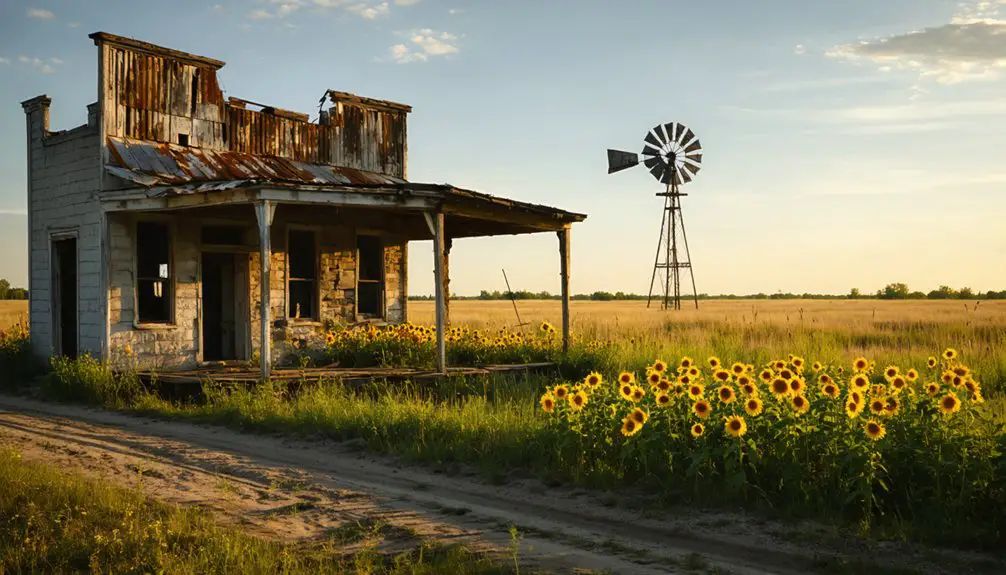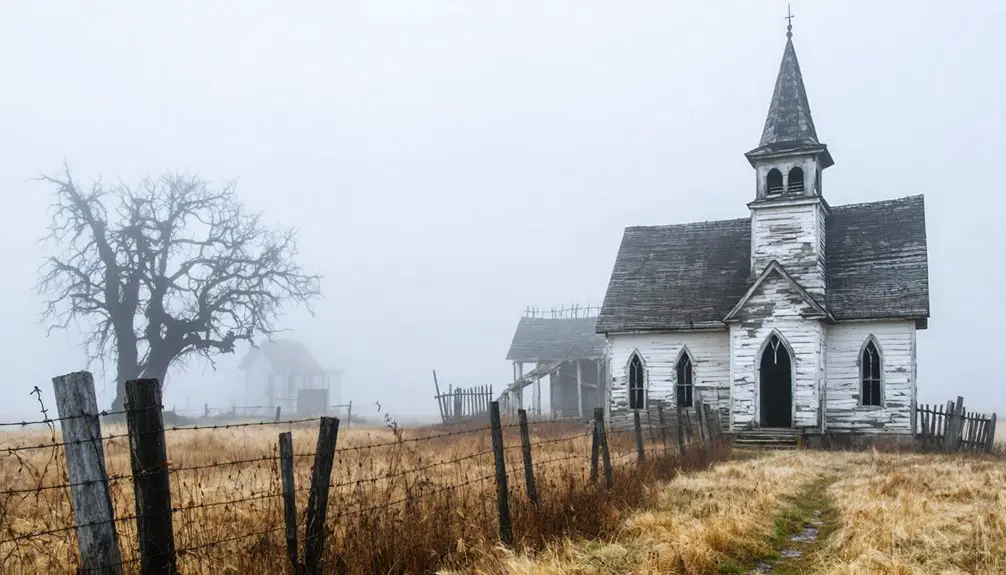You’ll find Xenia’s ghost town story in northwest Missouri’s Nodaway County, where it flourished as an essential stagecoach stop between St. Louis and Springfield in the mid-1800s. Named after the Greek word for “hospitality,” this pioneer settlement boasted a post office, mercantile store, and hotels from 1857-1872. When railroads arrived in the 1870s, the town quickly declined. Today, only a historical marker and farmhouse hint at the deeper tales of this vanished community.
Key Takeaways
- Xenia was a 19th-century Missouri settlement that served as a stagecoach stop between St. Louis and Springfield before becoming a ghost town.
- The town’s post office closure in 1872 marked the beginning of its decline as railroad development redirected commerce to other locations.
- Today, only a farmhouse and historical marker remain, with no original buildings or foundations surviving from the original settlement.
- Named after the Greek word for “hospitality,” Xenia operated as a vital commercial hub with hotels, merchants, and mills during its peak.
- The town’s abandonment occurred primarily due to the arrival of railroads in the 1870s, which shifted population and trade to better-connected communities.
Origins and Naming of Xenia
While the exact founding date remains unclear, Xenia emerged as a small settlement in northwest Missouri during the late 19th century, when the region saw an influx of settlers from states like Indiana and Pennsylvania.
The town’s name reflects common settler motivations of the era, derived from the Greek word for “hospitality.” Like Ohio towns including Mechanicsville and Caesarsville, small Missouri settlements often started with just a few buildings and residents. The name embodies the deep cultural value of showing respect to visitors, a tradition dating back to ancient Greece.
You’ll find this naming convention was likely inspired by the well-established city of Xenia, Ohio, as many Midwestern settlements adopted names from settlers’ previous homes or classical languages.
This practice aligned with the period’s popularity of Greek-inspired town names, which settlers used to convey ideals of civilization and friendliness.
While no explicit records detail Xenia’s specific naming process, it’s consistent with regional patterns where community consensus or prominent landowners influenced such decisions.
Life in a Stagecoach Stop Town
During its heyday in the mid-1800s, Xenia’s stagecoach stop emerged as the beating heart of the community, serving travelers along the bustling St. Louis to Springfield route.
You’d find the log structure buzzing with activity, as it offered more than just stagecoach hospitality – it was a crucial hub where locals and travelers alike gathered to exchange news and conduct business.
The stop’s strategic location made it essential for commerce and communication, featuring sleeping rooms upstairs and public dining spaces below. The South-Western Stage Company operated regular service through the town until 1869.
Community interactions flourished as diverse travelers mingled with residents, while the establishment supported local jobs and trade.
Even during the Civil War, when Union troops occupied the building as a hospital and barracks, it remained a focal point of local life, though its traditional functions were disrupted by military activity.
The Post Office Era: 1857-1872
After settlers established Xenia as a stagecoach hub, the town gained its official post office in 1857, named after Xenia, Ohio – likely reflecting the origins of early residents.
You’ll find that post office operations became central to the town’s identity, serving as a crucial communication link for locals during Missouri’s western expansion. Much like today’s minimum bet 200 options for modern entertainment, the postal services required small fees to operate.
The post office’s presence put Xenia on official postal maps, which were meticulously prepared by the Post Office Department’s Topographer. These maps helped travelers and settlers locate mail services throughout the region. Just as the Greek word xenos means stranger, the town welcomed many unfamiliar faces as they passed through seeking postal services.
For 15 years, the post office handled everything from personal letters to newspapers, including German-language publications that served Missouri’s diverse population.
When the post office closed in 1872, it marked a turning point in Xenia’s decline, though records of its operation survive in national archives.
Daily Commerce and Local Services
Beyond its postal operations, Xenia thrived as a bustling commercial center with an array of businesses and services.
You’d find a well-stocked mercantile store offering essential supplies, while the local hotel welcomed travelers making their way through town. The stagecoach stop brought regular traffic, strengthening the local economy through passenger and mail transport services. Like many settlements that became ghost towns later, Xenia’s economic vitality was closely tied to transportation routes.
The town’s commercial landscape included crucial community services like a sawmill for timber processing and a flour mill serving area farmers. These facilities created jobs and supported auxiliary businesses, demonstrating Xenia’s self-sufficient nature. The town remained an active hub until its post office closed in 1926.
You could handle your business at shops that often provided credit services, while the hotel, livery stables, and blacksmith shops kept the wheels of commerce turning. Hospitality venues doubled as social hubs, weaving commerce into the town’s social fabric.
Transportation Changes and Town Decline
While Xenia once thrived as an essential stagecoach stop, the arrival of railroads through neighboring Pickering and Hopkins in the 1870s spelled its eventual doom. The transportation evolution dramatically shifted commerce away from stagecoach-dependent towns, as railways offered faster, more reliable shipping options with greater freight capacity. Like many rural communities affected by mechanical farming, the town’s population steadily declined.
The rise of railroads marked the end for countless stagecoach towns, as steam engines revolutionized America’s transportation landscape.
The Kansas City Pittsburgh Railroad enabled similar transformations across the region, changing the fortunes of many small communities.
You’ll find the economic impacts were swift and severe. When the post office closed in 1872, it signaled the beginning of Xenia’s decline.
Businesses that once served stagecoach travelers couldn’t compete with rail-connected towns. Local merchants and residents gradually relocated to places like Pickering and Hopkins, following the new transportation corridors.
Today, Xenia’s limited accessibility via 2WD roads reflects its isolation, with only a farm home and historical marker remaining where a bustling community once stood.
What Remains Today
If you visit Xenia’s original location today, you’ll find just a solitary farmhouse still standing near the former town site.
A historical marker serves as the only official indication that a town once existed here, while the surrounding rural landscape has been completely transformed into farmland.
The town’s original commercial buildings, including its hotel and mercantile store, have vanished entirely, leaving no trace of the once-active community. Similar to hazardous waste disposal, Times Beach’s tragic environmental contamination highlights the devastating impact that toxic chemicals can have on small American towns.
Physical Site Today
Today’s landscape reveals no trace of the once-existing town of Xenia, Missouri. If you’re searching for archaeological findings, you won’t find any – the site has been completely reclaimed by nature and agriculture.
Unlike other Missouri ghost towns that maintain visible ruins or structures, Xenia’s physical presence has vanished entirely. You’ll find no foundations, no building remnants, and no preserved artifacts at the approximate coordinates of 40.474°N 94.781°W in Nodaway County.
The absence of ghost town characteristics makes Xenia particularly unique – it’s transformed from a settlement with a functioning post office into land that’s indistinguishable from its surroundings.
No archaeological surveys have been conducted, and without any physical evidence remaining, the town’s exact location remains unverified in the Geographic Names Information System.
Historical Markers Present
The absence of physical remains extends to historical markers at Xenia’s former location. You’ll find no official plaques or monuments specifically commemorating the ghost town’s historical significance.
The only nearby marker is at Soldiers Run Cemetery, located on private property about 1.5 miles west of the town site along State Route 125.
Local legends live on through a marker at “Bloody Bridge” over Ohio Brush Creek, which tells the story of town founder Simon Osman‘s fatal encounter with the Easter family in 1876.
While other Missouri ghost towns have markers highlighting their mills, bridges, and churches, Xenia’s story remains largely unmarked.
The cemetery’s tombstones offer the most tangible links to the town’s pioneer families, though they’re not accessible to the public.
Historical Significance in Nodaway County
You’ll find Xenia’s historical significance deeply rooted in its role as one of Nodaway County’s pioneer settlements, where early settlers established a significant community hub in 1857.
As a strategic stagecoach stop between larger towns, Xenia served travelers and merchants during Missouri’s pre-railroad era, making it a critical link in the region’s transportation network.
The town operated through the tumultuous Civil War period, with its post office and local businesses maintaining essential services from 1862-1863, reflecting the resilience of frontier communities during this pivotal time in American history.
Early Pioneer Settlement Origins
Established in 1845 as part of Missouri’s Platte Purchase, Nodaway County emerged from lands previously inhabited by Sac, Fox, and Iowa tribes who relinquished their territory through an 1836 treaty.
Pioneer challenges included traversing the tall prairie grasses and establishing homes along the region’s three north-to-south rivers and numerous creeks.
Early settlement strategies focused on utilizing natural resources and existing pathways. You’ll find that settlers followed indigenous trails, military roads, and exploration routes like Field’s Trace and Gray’s Trace to access the fertile uplifts known as “narrows.”
The abundance of wildlife, rich soil, and water access made the area particularly attractive to pioneers. These early settlers established communities like Xenia, which gained its first post office in 1857, named after its Ohio counterpart.
Stagecoach Route Importance
Following pioneer settlement patterns, stagecoach routes emerged as essential arteries connecting Nodaway County’s isolated communities in the mid-19th century. You’ll find that Xenia served as an important stop along these routes, where stagecoach innovations transformed the region’s connectivity.
The route logistics centered around strategic placement of inns and rest stops, making Xenia an important hub for travelers, mail delivery, and commerce.
These routes weren’t just transportation corridors – they became the lifeline of social and economic development. Local businesses thrived around the stops, while farmers and merchants gained reliable access to broader markets.
During the Civil War, these routes proved significant for military movements, though service faced disruptions. Even as railroads eventually superseded stagecoaches, the routes’ legacy shaped Nodaway County’s early development and established lasting community connections.
Civil War Era Impact
While Xenia itself didn’t witness major Civil War battles, the surrounding Nodaway County region endured significant wartime upheaval during the 1860s.
You’ll find that Confederate and Union forces regularly moved through the area, especially during Sterling Price’s 1864 retreat after the Battle of Westport. The conflict’s impact on local communities left lasting scars, with ghost stories and historical hauntings emerging from the era’s divided loyalties and guerrilla warfare.
Confederate sympathizers clashed with Union supporters while Bloody Bill Anderson’s raiders terrorized the countryside.
The war disrupted agriculture, mining, and trade routes, forcing many families to flee. Brig. Gen. Joe Shelby’s Iron Brigade and Union cavalry under James G. Blunt brought military action uncomfortably close to Xenia, forever changing the region’s social and economic landscape.
Frequently Asked Questions
Were Any Notable Civil War Events or Skirmishes Recorded in Xenia?
Like a blank page in history’s book, you won’t find specific Civil War battles in Xenia, though the town’s location in central Missouri meant it wasn’t spared the region’s widespread guerrilla warfare.
What Was the Peak Population of Xenia During Its Existence?
You’ll find limited records of this town’s historical significance, but based on comparable settlements and infrastructure markers, the peak population likely reached between 50-150 residents before its eventual decline.
Did Any Infamous Outlaws or Bandits Ever Pass Through Xenia?
You won’t find any documented evidence of notable outlaws or bandit legends passing through this area. The town’s brief existence and small size didn’t attract Missouri’s infamous criminal element.
What Happened to the Residents When the Town Became Abandoned?
You’ll find that resident migration patterns show locals moved to nearby towns and cities with better opportunities, while some stayed on surrounding farmland, leaving behind minimal ghost town preservation efforts.
Were There Any Schools or Churches Established in Xenia?
Like seeds planted in fertile soil, your ancestors had access to a one-room schoolhouse for education and likely attended local church services, though few official records of these institutions survive today.
References
- https://en.wikipedia.org/wiki/Xenia
- https://legendsofkansas.com/bourbon-county-extinct-towns/
- https://en.wikipedia.org/wiki/List_of_ghost_towns_in_Missouri
- https://www.ghosttowns.com/states/mo/xenia.html
- https://www.youtube.com/watch?v=OPNh93z9dNE
- https://ohioghosttowns.org/greene-county/
- https://collections.shsmo.org/manuscripts/columbia/C2366/nodaway-county
- https://www.youtube.com/watch?v=alC1wDdSVvg
- https://mostateparks.com/sites/mostateparks/files/Old Stagecoach Stop.pdf
- https://mostateparks.com/sites/mostateparks/files/PI6-6(11-12-96).pdf



